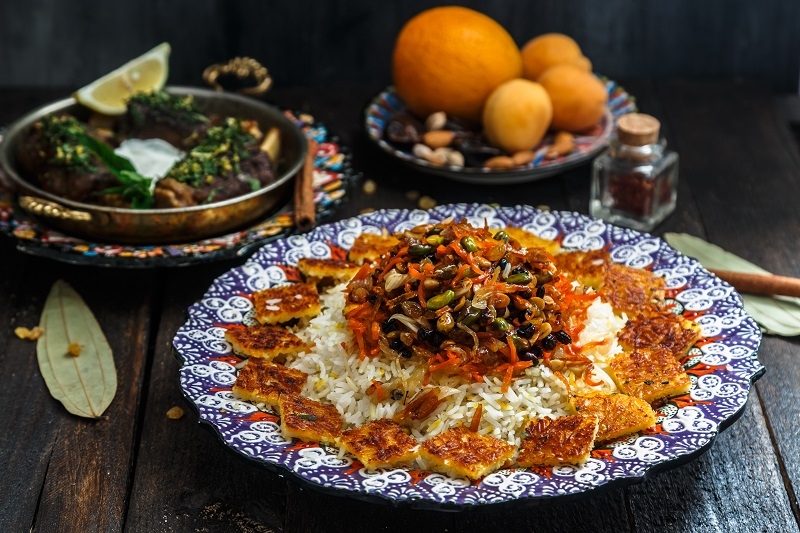
There is a certain poetry to Persian cuisine—a grace and elegance of flavor, fragrance, and texture that makes every meal a gourmet experience, regardless of how simple a dish might be. At the heart of this tradition lies rice: not merely a side dish but a centerpiece prepared with expertise, meticulousness, and respect. The Art of Persian Rice: Techniques Behind Tahdig and More is an everyday ritual taught and passed on as part of family and cultural tradition for generations.
You are not alone if you’ve ever been astonished by a Persian rice dish at a table and wondered how it was created. In this comprehensive guide, you will learn all the secrets you need to be equipped to take on Persian rice-making, from rice selection to tahdig mastery, as well as timeless cooking tips to take with you from Iran.
In most cultures, rice is a simple staple. In Iran, rice is a work of art.
Persian rice (berenj) is not just about sustenance but presentation, aroma, and yearning for a tender yet "held together" bite. A dish like chelow (plain white rice served with stews or kababs) gets as much respect in an Iranian kitchen as a roast dinner in a French kitchen. It is not as simple as boiling and fluffing. It is a methodology, a series of Persian rice techniques, a layering of flavors, and a holy grail crisped base (usually tahdig) that will have everyone at the table fighting for it.
This is why cooking Persian rice feels like composing. It is mathematical, expressive, and culturally rich.
Have A Look: Savor the Goodness of Persian Cuisine for a Healthier You
It all starts with the grain. There are many types of rice worldwide, but extra-long-grain basmati is the go-to for most Iranian households.
Reasons to use extra-long basmati:
While some Iranian purists favor local cultivars, such as Domsiah, most home cooks choose high-quality Indian or Pakistani basmati rice—both in quantity and quality—when trying to replicate a Persian dish outside of Iran.
Caution for Iranian cooks:
Rinse rice 3–5 times until the water runs clear. This washes the extra starch off the rice, which can cause stickiness and is an absolute no-no in Persian rice-making!
Once the rice is rinsed, it is soaked in slightly salted water for a minimum of 1-2 hours, which can help hydrate the grains evenly and provide greater odds of achieving a uniform texture. Some cooks add a splash of vinegar or lemon juice to keep the grains' vegetative structure intact. Others say adding a small amount of salt while soaking helps deepen the flavors.
Soaking the rice is a crucial step towards mastering cooking Persian rice—otherwise, it may clump, break, or not cook evenly.
Here is where Iranian cooking knowledge comes into view: after the rice is soaked, it is drained and boiled, or grained, in a pot of rapidly boiling salted water for about 6-8 minutes. The aim is to achieve soft rice on the outside while keeping it al dente or firm on the inside. The rice is considered to be ready when you bite a grain and feel a slight resistance in the center section of the grain.
Once boiled, the rice is drained and rinsed under cold water to stop cooking and discard some extra salt.
This two-step cooking process (boil and steam) achieves the legendary fluffy Persian rice.
Now comes the most iconic part of Persian rice making: the creation of tahdig—the crispy golden crust at the bottom of the pot.
This is where each cook gets to show their flair.
Types of Tahdig:
To build the tahdig, oil or butter is heated in the pot, followed by the base layer (bread, potato, or rice). Then, the rest of the rice is gently spooned on top in a pyramid shape.
A towel-wrapped lid or damkoni (fabric steamer cover) is placed over the pot to absorb moisture, and the rice is steamed on low heat for 45 minutes to 1 hour.

Getting that golden, crunchy bottom without burning is a rite of passage in Persian cuisine. Here are a few Iranian cooking tips to get it right:
The moment of truth comes when flipping the rice onto a serving platter. The tahdig will come out whole, golden, crackling, and glorious if done correctly.
Persian rice isn't just about texture. The aromas wafting from the pot are part of the experience. Some rice dishes are plain, while others are flavored during or after cooking.
Saffron, known as “red gold,” is a staple of Persian cuisine. It adds a luxurious color and a floral, earthy aroma that defines the dish.
Mastering the art of Persian rice takes patience. Here are some common errors:
Quick Iranian cooking tip:
Always taste your rice at every stage—soaking water, parboiling, and steaming—to ensure flavor is layered throughout.
Let’s break it down into a beginner-friendly version:
Ingredients:
Instructions:
You’ve just completed your first real tahdig recipe.
Don’t Miss Out: Persian Rice Spice: Flavor, Uses & Cooking Guide for 2025
To understand Persian cuisine is to appreciate its rice. It is ceremonial, sensory, and sacred. Whether you're savoring the simplicity of chelow or the extravagance of shirin polo, the effort behind each grain reflects a deep culinary heritage.
The Art of Persian Rice: Techniques Behind Tahdig and More isn’t just about food—it’s about identity, family, memory, and mastery. With the right ingredients, techniques, and a little love, you’ll find that Persian rice isn’t hard to make—it’s hard to forget.
This content was created by AI